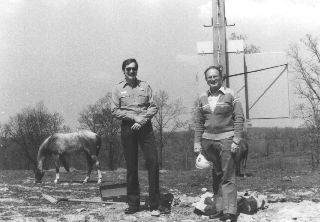|
|
 |
1985 National Park Installation
Left: Chris White.
Right: John Shoaf. |
TThe advent of the Travelers' Information
Station (TIS) began with various experimental stations and pilot
projects conducted in the 1930s-1970s in our National Parks as well as at certain airports,
highways and bridges.
As a result, the Federal Communications Commission issued a notice-of-inquiry;
and a rulemaking process ensued that led to
formal federal rules in 1977
that, with certain modifications, continue to govern the service.
Today Travelers' Information Stations are
tasked to inform not only travelers and commuters
but also to provide emergency updates to communities. The TIS service currently is a key
component in multimodal emergency management programs across the
United States (see "Related Links," below); because, in crises, timely local information simply
and directly disseminated by emergency officials is essential.
Below is a historical progression of
articles about the evolution of Travelers' Information Stations. Some
of the articles pre-date creation of the TIS service
by the Federal Communications Commission. The last article describes
how TIS is used today.
In the National Parks:
-
A bimonthly newsletter by, about and
for the National Park Service, the National Conference on State
Parks and the National Recreation and Park Association documents
early experiments with short-range, unlicensed radio
technology at national parks that later led to the advent of the
Travelers' Information Service.
See "Radio as an Aid to
Interpretation," Grist,
p.3, Sep-Oct 1957.
-
A 1972 issue of the newsletter talks
about the first low-power AM transmitters, when park
interpreters were told how "any park can transform a visitor's
car into a mobile interpretative laboratory."
See
"The Medium Has a Message,"
Grist, p.61-62, vol.16 #6,
Nov-Dec 1972.
-
This 283-page history of the development of telephone and radio
services in the National Park Service was released in 1991
on the 75th anniversary of the NPS. Beginning in 1916, it
documents technological advancements through 1991. “From Ground
Wire to Microwave; a Chronicle of fifty Years of Telephone and
Radio System Development in our National Park System,” compiled
by Ralph R. McFadden. Published by NPS-WASO-OE, Apr 26, 1991.
McFadden began as an engineer with the National Park Service in
1934 and retired as NPS Communications Officer in 1977.
-
Here's a summary update
of the above McFadden document by then NPS Wireless
Communications Chief Frank Weed,
published in conjunction with the NPS centennial in 2015. "Initial Studies Related
to Travelers' Information Stations" by Ralph McFadden (1991),
re-edited by Frank Weed (2015).
In Transportation:
-
"LAX Radio
and the Origin of the Travelers' Information Service" by Richard
Burden, 2012 -- about the beginning of TIS at LAX airport in the
early 1970s. The airport had major congestion problems created
by uninformed and confused motorists. LAX manager Clifton Moore
envisioned a need to broadcast helpful information to car
radios, thinking that if he could only talk to the drivers, he
could move traffic more effectively. The original installation
at LAX in 1972 had two buried induction cable systems, one on
the Century Boulevard approach road and one within the terminal
area. Each cable carried a different series of messages to
assist motorists. The frequency of 530 kHz was requested as an
aid to easily tuning to the end of the dial to locate the
service. The original 1972 installation, licensed as
“Developmental”, answered Moore’s vision, and became the model
for what we know today as the Travelers Information Service.
(Contributed by Richard Burden;
see his credentials.)
-
"Can You Monitor These Mini-Broadcasters? Little Known DX
Challenge Awaits Adventuresome Listeners!" by Smoki Whitfield,
Popular Communications & The Monitoring Magazine, 1983.
-
"Roadside Radio Smooths Traffic Flow,"
Popular Science, p.25,
Apr 1973 -- about the early use of radio at LAX airport in
Los Angeles, CA, published while the initial 2-year test of the
system was still underway (contributed by Richard Powers).
The TIS Service Today:
Related Links:
|
|

